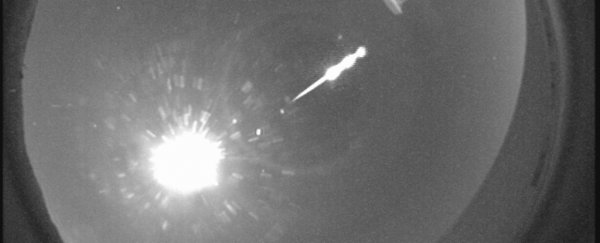October was an eventful month for skygazers, but things aren't slowing down any time soon. NASA scientists have predicted that the annual Taurid meteor shower is about to put on a once-in-a-decade event, known as the Taurid meteor swarm.
That means that over the next week and a half, we're expected to see frequent fireballs – extremely bright meteors – lighting up the night sky. The last time we saw this type of activity from the Taurids was in 2005, so we're pretty excited.
The Taurid meteor shower occurs every year between September and December, as Earth ploughs through the debris trailing behind by the Comet Encke.
Usually when we pass through this trail, we can expect to see the odd bit of dust hit our atmosphere at speeds of around 105,000 km/h (65,000 mph), but the result is pretty weak, and is outshone by other meteor events, such as the Perseid meteor shower.
But every 10 years or so, the Earth travels through a 'swarm' of larger space particles, which can produce frequent fireballs – extremely bright meteors – that light up the night sky. And all calculations point to 2015 being one of those years.
"The annual Taurid meteor shower is going on right now, and we are seeing steady activity in our meteor cameras," said Bill Cooke, who runs NASA's Meteoroid Environments Office. "Individuals should not be surprised if they see a bright meteor or fireball over the next few nights."
There are two streams of the Taurid shower, north and south, which broke off from the comet at slightly different times and therefore have different orbits. That means we're in for a week and a half straight of good viewing days – the south Taurid meteor shower hits its peak on November 5 and 6, with the north Taurid peaking on November 11 and 12.
And those dates are pretty fortunate, because they also happen to line up with some good viewing conditions. On the morning of November 5, the Moon will be a crescent, and won't rise until after midnight, which means that it won't block out too many of the smaller meteors.
The Moon will then continue to get thinner, and rise progressively later, as the week continues, until it becomes new on November 11, leaving the entire night dark for some unspoiled viewing.
To see the meteor shower, your best bet is to look towards the Taurus constellation, where it originates from. You can find out where that is, and when it's going to be highest in the sky for prime watching, using the free Star Chart app (Android or iPhone).
As you might imagine, the north Taurids can be seen north of the constellation, with the opposite being true for the south Taurids.
The Taurid meteor shower is also fascinating because scientists now believe that the debris trail may not only be coming from Comet Encke, but potentially from the disintegration of a much larger comet, which left Encke and other rubble in its wake.
That could explain why the shower contains larger chunks of debris and is more prone to producing fireballs than other meteor showers. But don't worry, this large debris is nothing to be alarmed about, as NASA scientists explained over on Reddit this weekend.


While it's still not 100 percent confirmed that this year is going to be a swarm year, the only way to find out is to get out there and watch the skies. We hope you're in for a treat!
And in the meantime we'll leave you with this, which is one of the most adorable space interactions we've seen in a long time:

